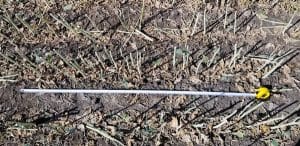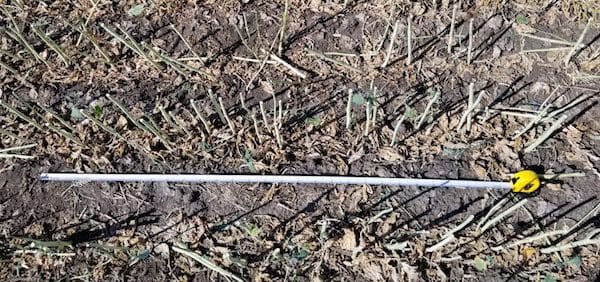Weather delays? Canola not ready to swath? Waiting for the next crops to be ready to combine? Take advantage of harvest down days to check canola fields for the following:
1. Clubroot. Don’t wait for obvious dead patches. Check random plants in high risk areas to see if they have clubs. If they do have clubs, destroy as many as you can. It may seem a daunting task and you won’t find them all with a random search, but the more you destroy now, the fewer spores will remain. Consider this: Seed growers spend weeks roguing crops for weeds and off-types. Ridding a field of clubroot deserves the same level of attention. Read more scouting tips. Send samples for DNA analysis. Top 10 observations from the International Clubroot Workshop.
2. Blackleg. Fields that started the season with moist soil conditions and fields that had hail early in the season could be at higher risk for yield-damaging blackleg. Fields in a tight canola rotation are also at higher risk. Clip stems to check for blackleg severity. Do 50 random stems (not just clearly damaged stems) to get a true picture of incidence (% of plants infected) and severity (average blackleg rating) for the field. If average severity is moving beyond 1.5 toward 2 or more, this is a clear sign that the blackleg resistance in the variety is no longer appropriate for this particular field. The blackleg pathogen population has shifted and R-gene rotation will be required the next time canola is grown on that field – unless the plan is to take a three-year break from canola. When making field scouting notes, include the variety name. Read more. See the article on race ID tests for blackleg.
3. Sclerotinia stem rot. Dry conditions will mean lower levels of sclerotinia across most regions this year, but what about your fields? Checking sclerotinia levels now will help assess fungicide application decisions. Read more. Take our very short survey on sclerotinia stem rot action and DNA petal tests.
4. Other diseases like grey stem or verticillium. Blackleg can sometimes be confused with root/foot rot or grey stem and sometimes verticillium. How to ID various diseases that can be found in canola this time of year. Read an article specific to identifying verticillium.
5. Plant density assessment. Plant counts can drop 10-15% through the season. If more severe than that, check scouting notes and consider the most likely reasons – Insects? Weather? Disease? Overcrowding? – and whether there’s a profit-improving way to prevent this. Seed choice may be part of the solution. If counts increase, which is also possible, take a close look at all plants in the harvest count to see how many are actually contributing to yield. Small spindly plants that emerged well after all the others may not have that many pods, and should not be included in the count. Another angle is to see how plant density may be affecting days to maturity. Big plants due to low density mean more branches and longer maturity. Read more.

6. Insects. You might still find bertha armyworm, lygus, flea beetles, grasshoppers and even cutworms at work this late in the season. But with harvest so close, pre-harvest intervals will be a concern if populations are near spray thresholds.
7. Insect damage. Seeing clear evidence of insect chewing on pods, in pods, on leaves and stems? If damage is enough to cause noticeable in yield loss, it may inspire a closer look next year.
8. How are varieties performing? Seed decisions for next year are already being made. Aside from yield (which is yet to be determined), how did this year’s varieties work out in terms of disease resistance, height, lodging? Is the pod shatter trait, if you went that way, also showing benefits for pod integrity after late-season hail and frost? Tool to help with seed decisions.
9. Review your notes on the season. Problems from earlier in the season can be tricky to diagnose this late, which is why keeping notes on observations all season long is so helpful. Review the notes from each field and add missing details now (while it might be fresh) rather than waiting until winter. Read more.
10. Weeds. Are those patches herbicide resistant and to what? Or are they just escapes?
—Herbicide resistant weeds tend to be in patches with only one weed species present. Other weeds were controlled while this particular species-specific patch was not. Herbicide-resistant weeds also tend to be in patches of irregular shape, starting off as one weed and going out from there as seeds shell out or the combine spreads them around. In the case of glyphosate-resistant kochia, plants are often in long lines as the resistant parent tumbled along dropping seeds. Wild oats will be in patches that spread out from the original resistant plants.
—Escapes tend to be multiple weed species. Weeds under the canopy may have missed herbicide contact, and these will usually be more than one species. Patches of escapes also tend to be in clear shapes, perhaps in arcs in headlands where the sprayer missed on a turn. Read more.
If weed patches could cause problems for straight combining, pre-harvest herbicide may be required to improve harvest logistics.

